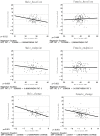Percentage of body fat assessment using bioelectrical impedance analysis and dual-energy X-ray absorptiometry in a weight loss program for obese or overweight Chinese adults
- PMID: 23573189
- PMCID: PMC3613423
- DOI: 10.1371/journal.pone.0058272
Percentage of body fat assessment using bioelectrical impedance analysis and dual-energy X-ray absorptiometry in a weight loss program for obese or overweight Chinese adults
Abstract
The current study aimed to compare the estimates of body fat percentage (%BF) by performing bioelectrical impedance analysis (BIA) and dual energy X-ray absorptiometry (DXA) in a sample of obese or overweight Chinese adults who participated in a weight-loss randomized control trial stratified by gender to determine whether or not BIA is a valid measurement tool. Among 189 adults [73 males, 116 females; age = 41 to 74 years; mean body mass index (BMI) = 27.3 kg/m(2)], assessments of %BF at the baseline and six months from the baseline were conducted by performing BIA and DXA. Bland-Altman analyses and multiple regression analyses were used to assess the relationships between %BFBIA and %BFDXA. Compared with DXA, BIA underestimated %BF [in males: 4.6, -2.4 to 11.7 (mean biases, 95% limit of agreement) at the baseline, 1.4, -7.4 to 10.2 at the endpoint, and 3.2, -4.8 to 11.3 in changes; in females: 5.1, -2.4 to 12.7; 2.2, -6.1 to 10.4; and 3.0, -4.8 to 10.7, respectively]. For males and females, %BFDXA proved to be a significant predictor of the difference between DXA and BIA at the baseline, the endpoint, and in changes when BMI and age were considered (in males: p<0.01 and R (2) = 23.1%, 24.1%, 20.7%, respectively; for females: p<0.001 and R (2) = 40.4%, 48.8%, 25.4%, respectively). The current study suggests that BIA provides a relatively accurate prediction of %BF in individuals with normal weight, overweight, or obesity after the end of weight-loss program, but less accurate prediction of %BF in obese individuals at baseline or weight change during the weight-loss intervention program.
Conflict of interest statement
Figures
Similar articles
-
[Comparison whole-body muscle mass assessed by dual-energy X-ray absorptiometry and multi-frequency bioelectrical impedance in overweight and obese adults].Zhonghua Yu Fang Yi Xue Za Zhi. 2017 Mar 6;51(3):215-219. doi: 10.3760/cma.j.issn.0253-9624.2017.03.005. Zhonghua Yu Fang Yi Xue Za Zhi. 2017. PMID: 28260334 Chinese.
-
Validity of electrical impedance myography to estimate percent body fat: comparison to bio-electrical impedance and dual-energy X-ray absorptiometry.J Sports Med Phys Fitness. 2019 Apr;59(4):632-639. doi: 10.23736/S0022-4707.18.08505-5. Epub 2018 Jul 18. J Sports Med Phys Fitness. 2019. PMID: 30024123
-
Agreement of bioelectrical impedance with dual-energy X-ray absorptiometry and MRI to estimate changes in body fat, skeletal muscle and visceral fat during a 12-month weight loss intervention.Br J Nutr. 2013 May 28;109(10):1910-6. doi: 10.1017/S0007114512003698. Epub 2012 Aug 31. Br J Nutr. 2013. PMID: 22935366
-
Good agreement between bioelectrical impedance and dual-energy X-ray absorptiometry for estimating changes in body composition during weight loss in overweight young women.Clin Nutr. 2007 Dec;26(6):771-7. doi: 10.1016/j.clnu.2007.08.003. Epub 2007 Oct 23. Clin Nutr. 2007. PMID: 17936443
-
Body composition assessment in individuals with class II/III obesity: a narrative review.BMC Nutr. 2024 Oct 22;10(1):142. doi: 10.1186/s40795-024-00913-2. BMC Nutr. 2024. PMID: 39438968 Free PMC article. Review.
Cited by
-
The Use of a Stem and Leaf Aqueous Extract of Cissus quadrangularis (CQR-300) to Reduce Body Fat and Other Components of Metabolic Syndrome in Overweight Participants.J Altern Complement Med. 2019 Jan;25(1):98-106. doi: 10.1089/acm.2018.0016. Epub 2018 Nov 12. J Altern Complement Med. 2019. PMID: 29912570 Free PMC article. Clinical Trial.
-
Performance of Body Adiposity Index and Relative Fat Mass in Predicting Bioelectric Impedance Analysis-Derived Body Fat Percentage: A Cross-Sectional Study among Patients with Type 2 Diabetes in the Ho Municipality, Ghana.Biomed Res Int. 2023 Apr 17;2023:1500905. doi: 10.1155/2023/1500905. eCollection 2023. Biomed Res Int. 2023. PMID: 37101689 Free PMC article.
-
Bio-impedance measurement allows displaying the early stages of neutrophil extracellular traps.EXCLI J. 2020 Nov 5;19:1481-1495. doi: 10.17179/excli2020-2868. eCollection 2020. EXCLI J. 2020. PMID: 33250682 Free PMC article.
-
Obesity and Cancer: A Current Overview of Epidemiology, Pathogenesis, Outcomes, and Management.Cancers (Basel). 2023 Jan 12;15(2):485. doi: 10.3390/cancers15020485. Cancers (Basel). 2023. PMID: 36672434 Free PMC article. Review.
-
Equation Córdoba: A Simplified Method for Estimation of Body Fat (ECORE-BF).Int J Environ Res Public Health. 2019 Nov 15;16(22):4529. doi: 10.3390/ijerph16224529. Int J Environ Res Public Health. 2019. PMID: 31731813 Free PMC article.
References
-
- Kannel WB, d'Agostino R, Cobb JL (1996) Effect of weight on cardiovascular disease. Am J Clin Nutr 63: 419S–422S. - PubMed
-
- Carroll K (1998) Obesity as a risk factor for certain types of cancer. Lipids 33: 1055–1059. - PubMed
-
- Alberti K, Zimmet P (1998) Definition, diagnosis and classification of diabetes mellitus and its complications. Part 1: diagnosis and classification of diabetes mellitus. Provisional report of a WHO consultation. Diabet Med 15: 539–553. - PubMed
-
- Consultation W (2000) Obesity: preventing and managing the global epidemic. World Health Organ Tech Rep Ser 894: i-xii, 1–253. - PubMed
-
- Kuczmarski RJ, Flegal KM, Campbell SM, Johnson CL (1994) Increasing prevalence of overweight among US adults. JAMA 272: 205–211. - PubMed
Publication types
MeSH terms
LinkOut - more resources
Full Text Sources
Other Literature Sources
Medical
Miscellaneous


